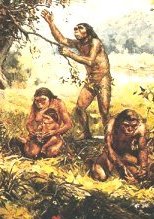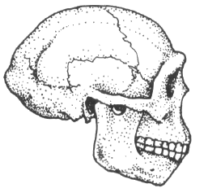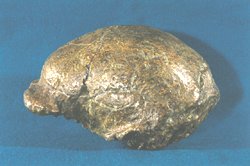 SKC Films Library |
| SKC Films Library >> Human Evolution |
| "Peking Man" the popular name for a pre-humanoid species that lived in what is now China between 500,000 and 300,000 years ago artist's conception of a Peking Man
family Skeletal remains indicate that Peking Man stood between 4½ and 5 feet. He had a brain capacity slightly smaller than modern man's, and used his brain to control fire and make stone tools. He was most likely a hunter-gatherer, capable of taking down game as large as himself. Excavation and Fossil History In 1918, Swedish geologist and archaeologist Johann Gunnar Andersson learned that there were some fossils at a site near Zhoukoudian. He subsequently surveyed the site and collected numerous rodent fossils. In 1921 and 1922, Andersson, accompanied by Austrian paleontologist Otto Zdansky, returned to Zhoukoudian and began excavating another promising site. In addition to more animal fossils, these excavations uncovered numerous quartz fragments that had characteristics suggesting that they had been "artificially" created. They also unearthed two human-like teeth. News of Andersson and Zdansky's finds gradually spread through the scientific community over the next few years, but little other excavation work was carried out until 1927, when Davidson Black decided to follow up the previous work. After finding another tooth he felt he had enough evidence to designate an entirely new genus and species of pre-humans -- Sinanthropus pekinensis. Based on nothing more than the one tooth in his possession and descriptions of the other two, Black determined that the species was capable of walking upright and possessed a measure of intelligence. some of the teeth found at
Zhoukoudian Not surprisingly, Black's assertion that three teeth (two of which he had never seen) were enough to create an entirely new genus was not well accepted by the scientific community, and Black traveled worldwide with "his tooth" to try and gain support for his position. He gained some support after half of a lower jaw with three teeth in place was found in 1928, but it was the discovery of a fairly complete skull at Zhoukoutian in 1929 that cemented Black's claim. Another skull was discovered later that same year, and Black's assertion that Peking Man represented a pre-human fossil became fairly widely accepted. However, his contention that Peking Man represented an entirely new genus was subsequently dismissed, and the specimens have since been reclassified as belonging to the Home erectus ancestral line. [The drawing of a Homo erectus skull below was based on a reconstruction done by Franz Weidenreich, which was itself based on bones from at least four different individuals.]
World War II forced all work at Zhoukoudian to come to an end, and all material collected to that point was supposed to be shipped to the United States; unfortunately none of the material ever made it to its appointed destination and its whereabouts remain a mystery to this day. Fortunately, the site was reopened to scientists in 1949, and numerous Homo erectus fossils that have been found there since. The entire site, which now encompasses more than 25 separate excavations, is now a registered World Heritage Site. first Peking Man skull cap
discovered SOURCES SEE ALSO |
| SKC Films Library >> Human Evolution This page was last updated on 06/19/2018. |



